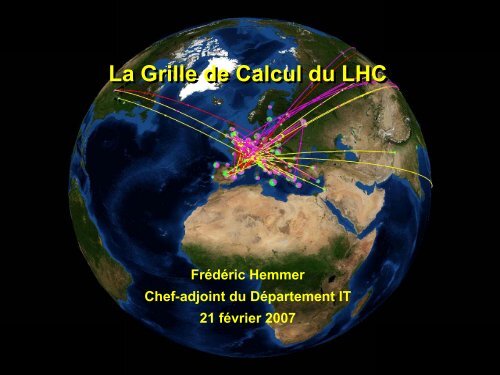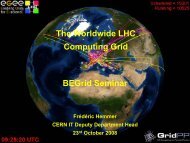La Grille de Calcul du LHC - Frédéric Hemmer - CERN
La Grille de Calcul du LHC - Frédéric Hemmer - CERN
La Grille de Calcul du LHC - Frédéric Hemmer - CERN
You also want an ePaper? Increase the reach of your titles
YUMPU automatically turns print PDFs into web optimized ePapers that Google loves.
<strong>La</strong> <strong>Grille</strong> <strong>de</strong> <strong>Calcul</strong> <strong>du</strong> <strong>LHC</strong><br />
Frédéric <strong>Hemmer</strong><br />
Chef-adjoint <strong>du</strong> Département IT<br />
21 février 2007<br />
Wolfgang von Frédéric Rü<strong>de</strong>n, <strong>Hemmer</strong>, <strong>CERN</strong>, <strong>CERN</strong>, IT Department Département IT <strong>La</strong> <strong>Grille</strong> <strong>de</strong> <strong>Calcul</strong> <strong>du</strong> <strong>LHC</strong> – septembre 2007
Le pari informatique <strong>du</strong> <strong>LHC</strong><br />
• L’accélérateur sera terminé en 2008<br />
et fonctionnera 10-15 ans<br />
• Les expériences vont pro<strong>du</strong>ire environ<br />
15 millions <strong>de</strong> Gigaoctets <strong>de</strong> données<br />
chaque année<br />
(environ 20 millions <strong>de</strong> CD!)<br />
• L’analyse <strong>de</strong>s données <strong>du</strong> <strong>LHC</strong> requiert<br />
une puissance informatique équivalente<br />
à±100’000 processeurs actuels les<br />
plus puissants<br />
• Cela nécessite la coopération <strong>de</strong><br />
plusieurs centres <strong>de</strong> calcul étant donné<br />
que le <strong>CERN</strong> ne peut fournir<br />
que ± 20% <strong>de</strong> cette capacité<br />
2<br />
<strong>La</strong> <strong>Grille</strong> <strong>de</strong> <strong>Calcul</strong> <strong>du</strong> <strong>LHC</strong> – février 2007
<strong>La</strong> solution: la <strong>Grille</strong><br />
• Utiliser la <strong>Grille</strong> pour réunir les ressources informatiques<br />
<strong>de</strong>s instituts en physique <strong>de</strong>s particules <strong>du</strong> mon<strong>de</strong> entier<br />
Le World Wi<strong>de</strong> Web fournit un<br />
accès simplifié à <strong>de</strong> l’information<br />
stockée en <strong>de</strong>s millions d’endroits<br />
<strong>La</strong> <strong>Grille</strong> est une infrastructure<br />
fournissant un accès simplifié à <strong>de</strong><br />
la puissance <strong>de</strong> calcul et <strong>de</strong><br />
stockage distribué tout autour <strong>du</strong><br />
globe<br />
3<br />
<strong>La</strong> <strong>Grille</strong> <strong>de</strong> <strong>Calcul</strong> <strong>du</strong> <strong>LHC</strong> – février 2007
Comment fonctionne la <strong>Grille</strong>?<br />
• Pour l’utilisateur final, elle donne à<br />
<strong>de</strong> nombreux centres <strong>de</strong> calcul<br />
l’apparence d’un seul système<br />
• L’intergiciel, un logiciel <strong>de</strong> pointe,<br />
trouve automatiquement les<br />
données et la puissance <strong>de</strong> calcul<br />
nécessaires aux scientifiques<br />
• L’intergiciel distribue la charge<br />
entre les différentes ressources.<br />
Il gère également la sécurité,<br />
la comptabilisation, la surveillance<br />
et bien plus…<br />
4<br />
<strong>La</strong> <strong>Grille</strong> <strong>de</strong> <strong>Calcul</strong> <strong>du</strong> <strong>LHC</strong> – février 2007
Une photo <strong>du</strong> détecteur ATLAS (en construction)<br />
150 millions <strong>de</strong> capteurs génèrent<br />
<strong>de</strong>s données …<br />
… 40 millions <strong>de</strong> fois par secon<strong>de</strong><br />
5<br />
The <strong>LHC</strong> Computing Grid – September 2007
6<br />
The <strong>LHC</strong> Computing Grid – September 2007
7<br />
The <strong>LHC</strong> Computing Grid – September 2007
8<br />
The <strong>LHC</strong> Computing Grid – September 2007
Le projet <strong>LHC</strong> Computing Grid (LCG)<br />
• Plus <strong>de</strong> 140 centres <strong>de</strong><br />
calcul<br />
• 12 grands centres pour<br />
la gestion initiale: le<br />
<strong>CERN</strong> (Tiers-0) et onze<br />
Tiers-1<br />
• 38 réseaux <strong>de</strong> plus<br />
petits centres (Tiers-2)<br />
• ± 35 pays impliqués<br />
9<br />
<strong>La</strong> <strong>Grille</strong> <strong>de</strong> <strong>Calcul</strong> <strong>du</strong> <strong>LHC</strong> – février 2007
10<br />
<strong>La</strong> <strong>Grille</strong> <strong>de</strong> <strong>Calcul</strong> <strong>du</strong> <strong>LHC</strong> – février 2007
Fiabilité et disponibilité <strong>de</strong>s sites<br />
• Tous les services grid <strong>de</strong> base sont déployés et utilises<br />
• The SRM v2.2 front-ends to mass storage systems being <strong>de</strong>ployed now<br />
– this has been a slow and lengthy process<br />
• Migration/<strong>de</strong>ployment of grid middleware to SL4 well un<strong>de</strong>r way<br />
• New CE (interface to batch systems) awaited to improve scaling<br />
• Focus is now on service reliability and evolution of performance – not on<br />
functionality<br />
• Amélioration gra<strong>du</strong>elle mais continue <strong>de</strong> la fiabilité <strong>de</strong>s<br />
sites<br />
• A peu près tous les sites Tier-1 sont proches ou au <strong>de</strong>ssus <strong>de</strong>s objectifs<br />
• Les expériences <strong>LHC</strong> utilisent <strong>de</strong>s a présent les outils <strong>de</strong> monitoring afin<br />
<strong>de</strong> tourner <strong>de</strong>s test spécifiques aux expériences.<br />
14<br />
The <strong>LHC</strong> Computing Grid – September 2007
LCG – 2007<br />
6000000<br />
5000000<br />
LCG Jobs run 2007<br />
<strong>LHC</strong>b<br />
165k/day<br />
CMS<br />
• LCG a exécuté ~ 44 M jobs en 2007 – la charge a<br />
continue a augmenter – maintenant a ~ 165k<br />
jobs/jour<br />
• <strong>La</strong> distribution <strong>du</strong> travail aux Tier 0/Tier 1/Tier 2<br />
illustre réellement l’importance <strong>de</strong> la grille<br />
• Les Tier 2 contribuent a ~ 50%; > 85% est en <strong>de</strong>hors <strong>du</strong> <strong>CERN</strong><br />
• Distribution <strong>de</strong>s données Tier 1s<br />
• Les objectifs <strong>de</strong>s taux <strong>de</strong> transfert maximums ont été obtenus<br />
avec <strong>de</strong>s charges <strong>de</strong> travail réelles pour ATLAS et CMS<br />
4000000<br />
3000000<br />
2000000<br />
1000000<br />
0<br />
Jan-07<br />
ATLA<br />
S<br />
Feb-07<br />
Mar-07<br />
Apr-07<br />
May-07<br />
Jun-07<br />
Jul-07<br />
Aug-07<br />
Sep-07<br />
Oct-07<br />
Nov-07<br />
Dec-07<br />
Target 2008<br />
16<br />
<strong>La</strong> <strong>Grille</strong> <strong>de</strong> <strong>Calcul</strong> <strong>du</strong> <strong>LHC</strong> – février 2007
Coup d’accélérateur avant le démarrage…<br />
3 X 2.9 X<br />
Sep‐06 Jul‐07 Avr‐08 Sep‐06 Jul‐07 Avr‐08<br />
Evolution <strong>de</strong> la puissance installée entre septembre 06 et juin 07<br />
Puissance cible promise dans le Protocole d’Entente<br />
pour 2007 (disponible en juillet) et 2008 (disponible en avril)<br />
17<br />
<strong>La</strong> <strong>Grille</strong> <strong>de</strong> <strong>Calcul</strong> <strong>du</strong> <strong>LHC</strong> – février 2007
Impact <strong>de</strong> la <strong>Grille</strong> <strong>de</strong> <strong>Calcul</strong> <strong>du</strong> <strong>LHC</strong> en Europe<br />
• Le projet LCG a donné un coup d’accélérateur au projet<br />
européen d’une <strong>Grille</strong> scientifique multi-usage EGEE<br />
(Enabling Grids for E-sciencE)<br />
• EGEE est maintenant un projet global et la plus gran<strong>de</strong><br />
<strong>Grille</strong> au mon<strong>de</strong><br />
• Co-financé par la Commission européenne (coût: ±130<br />
M€ sur 4 ans, financé par l’UE à hauteur <strong>de</strong> 70M€)<br />
• EGEE est déjà utile à plus <strong>de</strong> 20 applications dont…<br />
18<br />
Bio-informatique<br />
E<strong>du</strong>cation, Formation<br />
Imagerie Médicale<br />
<strong>La</strong> <strong>Grille</strong> <strong>de</strong> <strong>Calcul</strong> <strong>du</strong> <strong>LHC</strong> – février 2007
• EGEE<br />
Le projet EGEE<br />
– Démarré en avril 2004, maintenant dans sa 2 ème phase<br />
avec 91 partenaires dans 32 pays<br />
– 3 ème phase (2008-2010) en préparation<br />
• Objectifs<br />
– Etablir une grille pro<strong>du</strong>ctive pour<br />
l’e-Science à très gran<strong>de</strong> échelle<br />
– Attirer <strong>de</strong> nouvelles ressources<br />
et <strong>de</strong>s utilisateurs issus <strong>de</strong><br />
l’in<strong>du</strong>strie et <strong>de</strong> la science<br />
– Maintenir et améliorer ”gLite”,<br />
la couche intergicielle pour la<br />
<strong>Grille</strong>
• Plus <strong>de</strong> 25 applications dans un<br />
nombre croissant <strong>de</strong> domaines<br />
– Astrophysique<br />
– Chimie par modélisation numérique<br />
– Sciences <strong>de</strong> la Terre<br />
– Simulation financière<br />
– Fusion<br />
– Géophysique<br />
– Physique <strong>de</strong>s Haute Energies<br />
– Sciences <strong>de</strong> la Vie<br />
– Multimédia<br />
– Sciences <strong>de</strong> la matière<br />
– …..<br />
Applications sur EGEE<br />
Rapport disponible sur : https://edms.cern.ch/document/722132
Exemple: la grippe aviaire<br />
• EGEE a été utilisé pour analyser<br />
300’000 médicaments potentiels<br />
contre le H5N1, le virus <strong>de</strong> la grippe<br />
aviaire.<br />
• 2000 ordinateurs dans 60 centres<br />
<strong>de</strong> calcul en Europe, en Russie, en<br />
Asie et au Moyen-Orient ont tourné<br />
pendant 4 semaines en avril:<br />
l’équivalent <strong>de</strong> 100 années sur un<br />
seul ordinateur!<br />
• Les médicaments les plus<br />
prometteurs ont été i<strong>de</strong>ntifiés et<br />
classés.<br />
Neuraminidase, one of the two major<br />
surface proteins of influenza<br />
viruses, facilitating the release of virions<br />
from infected cells. Image Courtesy Ying-<br />
Ta Wu, Aca<strong>de</strong>miaSinica.
• Première application<br />
in<strong>du</strong>strielle fonctionnant sur<br />
EGEE<br />
• Développée par la Compagnie<br />
Générale <strong>de</strong> Géophysique<br />
(CGG) en France, qui effectue<br />
<strong>de</strong>s simulations<br />
géophysiques pour le<br />
pétrole, le gaz, les mines etc...<br />
• EGEE a aidé la CGG à mettre<br />
en réseau ses ressources<br />
informatiques à travers le<br />
mon<strong>de</strong>.<br />
Exemple: analyse <strong>du</strong> sous-sol
Durabilité<br />
• Nécessité <strong>de</strong> préparer une <strong>Grille</strong> permanente<br />
• Garantir un haut niveau <strong>de</strong> service à tous les utilisateurs<br />
• Ne plus dépendre <strong>de</strong>s financements <strong>de</strong> projet à court<br />
terme<br />
• Gérer l’infrastructure en collaboration avec les projets<br />
nationaux (National Grid Initiatives - NGI)<br />
• European Grid Initiative (EGI)<br />
23<br />
<strong>La</strong> <strong>Grille</strong> <strong>de</strong> <strong>Calcul</strong> <strong>du</strong> <strong>LHC</strong> – février 2007
Pour plus d’informations sur la <strong>Grille</strong>:<br />
www.gridcafe.org<br />
www.cern.ch/lcg<br />
www.eu-egee.org<br />
Merci pour votre attention!<br />
24<br />
<strong>La</strong> <strong>Grille</strong> <strong>de</strong> <strong>Calcul</strong> <strong>du</strong> <strong>LHC</strong> – février 2007



